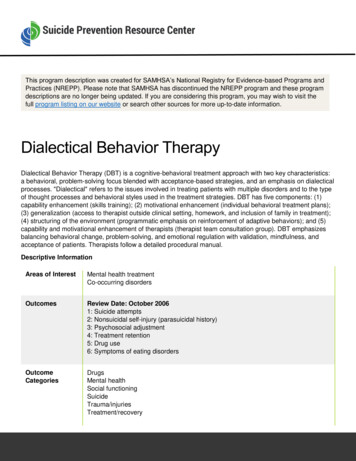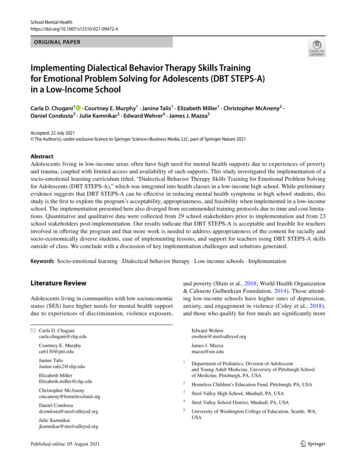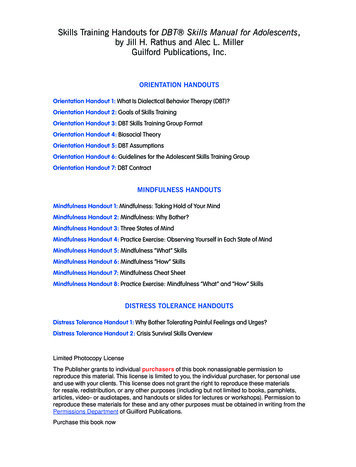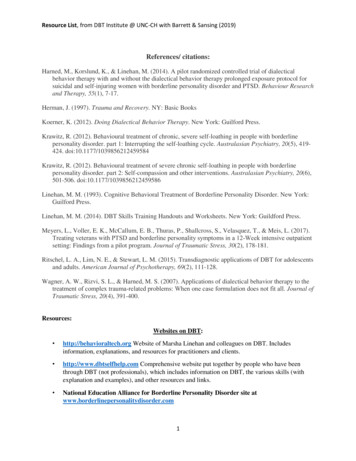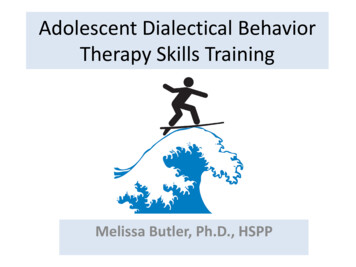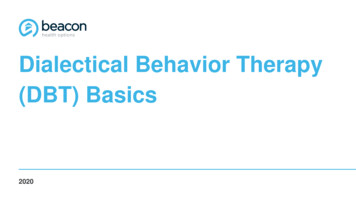
Transcription
Dialectical Behavior Therapy(DBT) Basics20203
Presenter Matthew Rynkiewicz, LCSW Master of Social Work (2007) Experienced in direct clinical care as well as mentalhealth program coordination DBT group facilitator since 2013 Received 65 hours of intensive DBT training Beacon Quality Management Specialist since 20174
Learning Objectives Identify the elements of comprehensive Dialectical Behavior Therapy (DBT) programs Describe the history and philosophy of DBT Explain how the functions of DBT treatment and modes of therapy are used to createsuccessful clinical interventions Demonstrate how DBT skills training works through demonstration of techniques5
Chapter01What isDialecticalBehaviorTherapy?8
What is Dialectical Behavior Therapy (DBT)? DBT is a type of cognitive behavioral therapy Focuses on increasing an individual’s ability tocope with intense emotions in healthy ways “Emotional Sensitivity” Transactional theoryoInvalidating environments9
History of DBT Developed by Marsha Linehan in the1980s & early 1990s Treatment manual published in 1993 Originally intended to treat BorderlinePersonality Disorder Dr. Linehan and her team addedtechniques and developed a treatmentthat would meet the unique needs ofthese patients.Photo from University of Washington10
What are Dialectics? DBT incorporates a philosophical processcalled dialectics Everything is composed of opposites Change occurs when there is a "dialogue"between opposing forces Dialectics makes three basic assumptions All things are interconnected Change is constant and inevitable Opposites can be integrated to form acloser approximation of the truth12
Wise Mind Practice Think of something bothering you in your life that is unresolved.13
Goals of DBTCope with stress in healthy waysLearn to regulate emotionsImprove interpersonal relationshipsLive in the moment14
What makes a good DBT candidate? DBT is intended to treat high risk, multiplediagnosis individuals with pervasive, severeemotion dysregulation Individuals with high emotional reactivity, engagingin problem behaviors Commitment to change is not a prerequisitePhoto from WestSide DBT15
DBT is Effective for the Following ConditionsBorderlinePersonalityDisorderCluster BPersonalityDisordersSuicide andSelf-harmingBehaviorADHDSubstance UseDisordersPTSDMood DisordersEating disorders(Binge andBulimia)16
DBT Effective in onCostsDepression& SuicidalBehavior17
18Photo from Behavioral Tech 2019
Who can perform DBT?TherapistsCounselorsSocial WorkersCase ManagersTraining:Milieu Staff 2 week intensive courses on clinical teams Certification available via Behavioral Tech19
Chapter02How does DBTWork?20
DBT Basics Individual takes ownership oftheir recovery, - self-sufficiency. Homework Tracking emotions, urges, &behaviors Individual and therapist worktogether to: Resolve the apparentcontradiction between selfacceptance Skills Training - encouragepositive behaviorsPhoto from Allure.com 10/23/1921
DBT AssumptionsIndividuals are doing the best they canIndividuals want to improveIndividuals need to do better, try harder, and be more motivated to changeAll behavior is causedIndividuals may not have caused their problems, but it is up to them to solve them anywayFiguring out and changing the causes of behavior is more effective than judging and blamingNew behavior needs to be learned in all relevant contexts22
Behavioral Skills Training DBT assumes that the problems exhibited byindividuals are caused by skills deficits. Failure to use effective behavior is often a resultof not knowing skillful behavior, or when / how touse it Skills Trainings teaches the individual a set ofbehavioral skills to strengthen their ability to usethose skills in their everyday livesooooMindfulnessEmotion RegulationInterpersonal EffectivenessDistress Tolerance23Photo from Psychiatric Times, 2016
Stylistic ApproachesValidation Acknowledging the truth in an individual’s experienceIrreverence Challenging patterns in the individuals perceptions & behaviors to get “unstuck”Dialectics Synthesizing opposites to get closer to the truthUse of Metaphor Using stories & symbols to illustrate conceptsObserving Limits vs. Setting Boundaries Within the therapeutic relationship; accepting what we can & can’t tolerate24
Stages of DBTPre-treatmentStabilization Orientation to DBT 1:1 meeting withtherapist EstablishingcommitmentTargets: Life ThreateningBehavior Therapy InterferingBehavior Quality of LifeInterfering BehaviorInterventions: 1:1 Therapy Skills Training Phone coaching Consultation Team Ancillary TreatmentsSymptomReductionProblems inlivingTargets: Reduce SymptomsTargets: Improve self-worth Problem solving Utilize supportsInterventions: 1:1 Therapy Skills Training Phone coaching Consultation Team Ancillary TreatmentsInterventions: 1:1 Therapy Skills generalizationIncompletenessTargets: Increasing capacityfor joy and freedomInterventions: 1:1 Therapy Pursuing meaningand purpose25
Secondary Targets for Borderline PersonalityEmotional Vulnerability vs. Self-InvalidationDialecticalTensionsUnrelenting Crisis vs. Inhibited ExperiencingActive Passivity vs. Apparent Competence26
Chapter03Components andModalities ofDialecticalBehaviorTherapy27
Two Main Treatment SettingsIndividual TherapySkills Group (Group Sessions) Consists of one-on-one contact with atrained therapist Group led by one trained therapist Therapist helps individual: Group meets weekly for 6 monthsostay motivatedoapply DBT skills within daily lifeoaddress obstacles that might ariseover the course of treatment. Each session lasts 2 hours Group members share experiences /provide mutual support Assigned homework or exercises Groups can be shorter/ longer –depends group members’ needs28
Modes of DBTIndividualTherapySkillsTraining BehavioralTargets Diary Cards Behavioral ChainAnalysis DevelopingCommitment Mindfulness Skills InterpersonalEffectiveness DistressTolerance EmotionRegulationCoachingPhoneCalls SkillsGeneralization Behavioral ChainAnalysis Crisis InterventionTherapistConsultation Therapy for thetherapist Problems intherapy Cheerleading ProvidingDialectical BalanceAncillaryTreatments MedicationManagement CaseManagement Group Therapy Vocational &EducationalAssistance29
IndividualTherapySkillsTrainingCoachingPhone CallsTherapistConsultationAncillaryTreatments Behavioral Targets Diary Cards Behavioral Chain Analysis Developing Commitment30
IndividualTherapyBehavioral Targets (Stage 1)Pre-treatmentStabilization Orientation to DBT 1:1 meeting withtherapist EstablishingcommitmentInterventions: 1:1 Therapy Skills Training Phone coaching Consultation Team Ancillary TreatmentsTargets:Threatening1 LifeBehaviorInterfering2 TherapyBehaviorof Life3 QualityInterfering BehaviorSymptomReductionProblems inlivingInterventions: 1:1 Therapy Skills Training Phone coaching Consultation Team Ancillary TreatmentsInterventions: 1:1 Therapy Skills generalizationTargets: Reduce SymptomsTargets: Improve self-worth Problem solving Utilize supportsIncompletenessInterventions: 1:1 Therapy Pursuing meaningand purposeTargets: Increasing capacityfor joy and freedom31
IndividualTherapyBehavioral Chain AnalysisDBT requires evaluation of the Behavior How is the behavior conditioned?oClassically conditioned – cue is paired with the behavioroOperantly conditioned - reward/ punishment following behavior Behavior Chain AnalysisLinksVulnerabilities FactorsprecedingproblembehaviorTriggeringEvent Cuespreceding thebehavior Identifyactions, bodysensation,cognitions,events ers Following theproblembehavior32
Diary CardsIndividualTracksIndividualTherapyIncidents of behavioral targets, urges to engage in thebehavior (scale of 1-5)Incidents of substance and alcohol useConsistency with medication regimenPractice of skills over the last weekReviewonly inIndividualtherapyReview inIndividual therapy& Skills Training33
Diary Card ExampleIndividualTherapy34
Developing commitmentIndividualTherapy IndividualsoCommit to making changes to cues, practicing skills, using interpersonal skills with others TherapistsoDo not assume commitment, and do not assume that commitment to change will be uniformacross treatment Strategies including are used at the end of sessions to ensure commitmentoPros & ConsoFoot in the Door35
IndividualTherapySkillsTrainingCoachingPhone CallsTherapistConsultationAncillaryTreatments Mindfulness Skills Interpersonal Effectiveness Distress Tolerance Emotion Regulation36
Mindfulness SkillsSkillsTraining Wise Mind “What” SkillsoObserveo“Teflon mind”oDescribeoParticipate “How” Skills – Non-Judgmentally,One Mindfully, EffectivelyPhoto from Psychology Compass37
Interpersonal Effectiveness SkillsImprove ability to Clearly communicate with others Say “no”Objectives Observe limitsEffectiveness Head off conflictSelf Respect Attend to sSkillsTraining DEARMAN FAST GIVE38
SkillsTrainingTools for Interpersonal MindfulAppear ConfidentG GentleI InterestedV ValidateE Easy MannerFASTFairApologiesStick to ValuesTruthfulNegotiate39
Distress ToleranceSkillsTraining Tolerating distressing situations without engaging in problem behaviorsCrisisSurvivalSTOP skillPros and consTIPDistractionSelf-soothingImproving the momentRealityAcceptanceSkillsRadical acceptanceTurning the mindHalf-smileWilling handsWillingness versus willfulnessMindfulness of current thought40
PRACTICE: Radical AcceptanceSkillsTraining Think back to the problem you used earlieroIs there anything about the problem – about yourself, someone else, the world aroundyou that you might be fighting?oAnything you’re resisting, or makes you feel tense about the situation?oGet comfortable and relax and open yourself to acceptance of the situation. Did you feel any different?41
Emotion RegulationSkillsTraining Reducing the intensity of emotion statesthat can cue engagement in problembehaviors Steps involvedoObserving emotionsoChanging emotional responsesoReduce emotional vulnerability— Examples – ABC, PLEASE42
IndividualTherapySkillsTrainingCoachingPhone CallsTherapistConsultationAncillaryTreatments Skills Generalization Behavioral Chain Analysis Crisis Intervention43
CoachingPhone CallsSkills Generalization Behavior needs to be learned across allenvironments Phone coachingoIncreases the likelihood that individuals will beable to apply newly learned skills in all contextsoProvides in the moment reinforcement of skills44
Behavioral Chain Analysis (Via Phone)CoachingPhone Calls In the moment evaluation of current cues, urges, emotions and reinforcers Therapist evaluates when the member began to experience urges Therapist coaches through the identification and execution of skillful means to preventengagement in problem behaviors Contingency management (if all else fails .) Needs to happen BEFORE the problem behavior has occurred, not after- otherwisehaving your therapist on the phone becomes reinforcement of behavior (24 hour rule)45
Crisis Intervention (as needed)CoachingPhone Calls Engagement of suicide assessmentprotocols/ safety protocols as needed Assisting by using skills to return tobehavioral chain analysis, and avoidproblem behaviors (ie. distress tolerance) Last Resort - Hospitalization and use ofemergency roomsIllustration by Brittany England via healthline.com46
IndividualTherapySkillsTrainingCoachingPhone CallsTherapistConsultationAncillaryTreatments Therapy for the therapist Problems in therapy Cheerleading Providing DialecticalBalance47
TherapistConsultationTherapy for thetherapist(weekly)Problems age from vectorstock.com48
IndividualTherapySkillsTrainingCoachingPhone CallsTherapistConsultationAncillaryTreatments Medication Management Case Management Group Therapy Vocational & Educational49
entGroup TherapyVocational &Educational50
Chapter04In Summary51
Key TakeawaysComprehensive DBT programs can be an effective way to treat clients with high riskbehavior, multiple diagnoses and emotion dysregulationDBT works! Studies continue to show that comprehensive programs and skills trainingcan be effective interventions to reduce problem behaviorsTherapists interested in providing DBT should explore training options as thetreatment is extensive and requires a degree of expertiseUse the Behavioral Tech Website to find a therapist apist/52
Thank youContact aconhealthoptions.com55
References American Psychiatric Association (1998). Gold Award: Integrating dialectical behavior therapy into a community mental health program. Psychiatric Services, 49(10). 1338–1340. DeCou, C.R., Comtois, K.A., & Landes, S.J. (2019). Dialectical Behavior Therapy is effective for the treatment of suicidal behavior: A meta-analysis. Behavior Therapy, 50 (1), 60-72. Linehan, M.M. (1993). Cognitive Behavioral Treatment of Borderline Personality Disorder. Guilford Press. Linehan, M. M. (2015). DBT Skills Training Manual (2nd ed.). Guilford Press. Linehan, M. M. (2015). DBT skills training handouts and worksheets (2nd ed.). Guilford Press. Koerner, K. (2012). Doing Dialectical Behavior Therapy: A Practical Guide. Guilford Press. Meyers, L. L., Landes, S. J., & Thuras, P. (2014). Veterans’ service utilization and associated costs following participation in dialectical behavior therapy: a preliminary investigation.Military Medicine, 179(11), 1368-1373 Robins, C.J. (2002). Zen Principles and Mindfulness Practice in Dialectical Behavior Therapy. Cognitive and behavioral practice, 9 (50-57). Robins, C.J., Schmidt, H. III & Linehan, M.M. (2004). Dialectical Behavior Therapy: Synthesizing Radical Acceptacnce with Skillful Means. In S.C. Hayes, V.M. Follette & M.M. Linehan(Eds.), Mindfulness and Acceptance: Expanding the cognitive-behavioral tradition (p. 30-44). Guildford Press. What is the ‘B’ in ‘DBT’? Video retrieved on 5/22/2020 from cal-behavior-therapy-dbt/?wvideo uv5bukdwi7 What is the ‘D’ in ‘DBT’? Video retrieved on 5/22/2020 from https://behavioraltech.org/resources Behavioral Tech (2019) How DBT Helps. Retrived on 5/22/2020 from https://behavioraltech.org/research/how-dbt-helps/ Schimelpfening, Nancy. (2020) Overview of dialectical behavior therapy. Retrieved on 6/2/2020 from therapy-1067402 Dialectical behavior therapy manual (2017) Retrieved on 6/2/2020 from https://static1.squarespace.com Smith, E. (2019, August 19). Dialectical Behavior Therapy: How Does It Work?, HealthyPlace. Retrieved on 2020, June 2 from -it-work Harned, M.S., & Botanov, Y. (2016) Dialectical behavior therapy skills training is effective intervention. Psychiatric Times, 33 (3).56
Veterans’ service utilization and associated costs following participation in dialectical behavior therapy: a preliminary investigation. Mil
